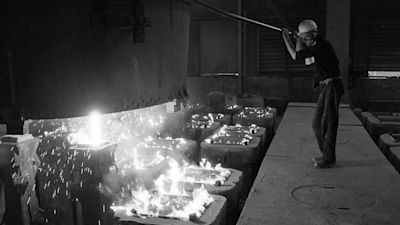Tata Steel: What is the difference between a blast furnace and an electric arc furnace?

Tata Steel has announced thousands of steelworkers will lose their jobs as the plant starts to use a electric arc furnaces to produce steel.
The company says the new technology, which costs more than £1 billion, will allow them to make steel in a more environmentally friendly way.
The Port Talbot plant currently uses blast furnaces. But how does the new technology work, and why will the changes cost so many jobs?
How does a blast furnace work?
In order to make steel using a blast furnace, first iron needs to be produced. Steelworkers do this by adding iron ore, coke and limestone into the furnace.
Coke is a coal-based fuel which is packed full of carbon.
Inside, the furnace is heated to more than 1,000°C using extremely hot air which is 'blasted' into the furnace.
These three ingredients burn and combine to create molten iron at the bottom of the furnace. All the impurities in the mix combine with the limestone to create a byproduct, called 'slag'.
The molten iron is taken out of the furnace and is then refined using oxygen, ultimately creating steel.
According to a 2021 World Steel report, making steel this way emits around 2.32 tonnes of CO2 per tonne of steel.
How does an electric arc furnace work?
Electric arc furnaces produce steel differently. The furnace is filled with cold recycled steel. Then electrodes are lowered into the furnaces.
Electric currents are passed through the electrodes which heats up the furnace like an oven and melts the scrap steel.
Limestone, fluorspar, carbon and oxygen can then be added to purify the steel.
The arc furnace uses a lot less energy than blast furnaces. They are much greener than the blast furnaces in Port Talbot. If 100% of the material used is scrap metal, scientists suggests that only 0.67 tonnes of CO2 is produced tonne of steel.
However, running an electric arc furnaces costs jobs. Put simply, the process requires fewer steps and ultimately fewer people. For example, in the arc process far less raw materials are used which means there is less need for steelworkers.
Why is the industry decarbonising?
To reduce the amount of greenhouse gases pumped into the atmosphere and stop the Earth heating up which would help to maintain a safe climate.
It is also a legal requirement to decarbonise under the government’s net zero plan as well as in keeping with its international obligations under the Paris Agreement.
The Climate Change Committee has suggested the Government “set targets for ore-based steelmaking to reach near-zero emissions by 2035”.
All four coal furnaces are approaching the end of their lifespan and must be replaced. The government said replacing all coal furnaces would reduce the UK’s carbon emissions by around 1.5%.
How are other countries decarbonising steel?
There are are currently 38 green steel projects in progress across the EU, nine of which are in Germany.
No country is yet producing steel using green hydrogen though Germany has one plant using blue hydrogen, meaning the gas is made from fossil fuels.
The UK has one project in the pipeline on the Humber which would use blue hydrogen.
Want a quick and expert briefing on the biggest news stories? Listen to our latest podcasts to find out What You Need To Know…